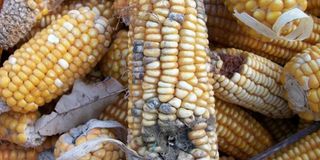Tanzania announces new plan to curb aflatoxin

What you need to know:
- The measures include application of approved insecticides against insect infestation in stored bulk grains.
Arusha. The government has announced a string of measures to control aflatoxin, a poisonous and carcinogenic fungi.
The measures include application of approved insecticides against insect infestation in stored bulk grains.
Others are establishment of mini labs at the border posts and training of farmers and other stakeholders on aflatoxin prevention.
This was announced by a senior official of the Arusha-based Tanzania Plant Health and Pesticide Authority (TPHPA), Dr Mahamudu Mohamed Sasamalo.
Also roped in the project, according to him, is the Tanzania Initiative for Preventing Aflatoxin Contamination (Tanipac) Project.
He said at least 14 mini laboratories have been established at the border posts while a superior lab has been set up at Kibaha.
Among the measures that have worked successfully were the application of Alfasafe in the crop fields against infestation by the fungi.
Dr Sasamalo was speaking during a regional workshop in Kampala that discussed aflatoxin prevention and control in the East African Community (EAC) region.
The meeting was convened to assess the progress made so far by EAC partner states on implementation of the regional strategy on aflatoxin prevention and control and craft the way forward on aflatoxin containment in EA.
It is estimated that agricultural commodities account for about 65 percent of intra-regional trade in the EAC.
It is further estimated that losses associated with aflatoxin contamination in Africa have escalated to $670 million annually.
Aflatoxin also accounts for 30 percent of liver cancer cases in Africa, according to a statement by the EAC secretariat.
Dr Sasamalo added that the Tanipac project has benefitted and built the capacities of 10,853 farmers, including 3,926 females with two (20 warehouses being established in Zanzibar and 12 in the Mainland).
This has seen Purdue Improved Bags (PICS) being distributed to farmers as well as training on aflatoxin prevention for farmers, processors, distributors, traders across 18 districts.
A trade policy, research and advocacy manager with the East African Grain Council (EAGC) Mr. Kimwaga Mhando said that the aflatoxin results in suppression of intra-regional trade in grains.
According to him, Tanzania and Uganda lose approximately $16 million and $5.3 million respectively due to the reduced value of agricultural exports resulting from aflatoxin contamination.
“There are high levels of grain rejection by off-takers in the region. Kenyan millers on average rejected 19 percent of maize deliveries to their factories in 2015.Rejections by millers are as high as 60 percent on some occasions,” he said.
Experts estimate that aflatoxin reduces the amount of food available for consumption (in terms of caloric value by 18 percent, 15 percent and 11 percent in Kenya, Uganda and Tanzania respectively.
This, according to the EAGC official, tends to create a food security gap in the region.
In order to address the issue of aflatoxin contamination, there was a need for self-industry regulation involving diverse measures.
These include promoting good agricultural practices; registration of value chain players; promotion of good manufacturing practices; certification of warehouses and warehouse operators.
Others are awareness creation and capacity building of value chain players, including consumers, and incentivising food safety compliance, among other measures.




